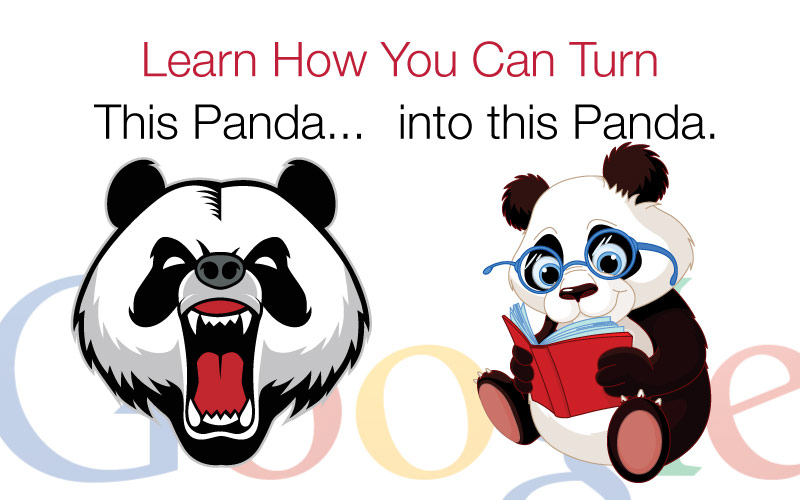
In February 2011, Google released the original “Panda” algorithm update and forever changed the rules for successful online content. Prior to Panda, many of the websites that were the most successful at getting to the top of Google rankings were content aggregators and sites that features many pages of thin or low quality content. Most of these sites were good at technical optimization and link building, but they were not investing in the creation of high quality original content… and this was becoming a problem.
Often times these big aggregators were getting the content they were scraping to rank higher in Google than the sites that had created that content. Therefore, the aggregators were getting all the traffic and advertising revenue, and the content creators were getting no incentives to create high quality content. This was driving down the overall quality of content online, and polluting Google’s search results.
So, Google went to work on this problem and in February 2011, released an algorithm update named Panda that sought to reward the originators of content, separated high quality content from low quality content and did a better job at understanding the intent of every search. When you think about it, this is actually a very complex task. How do you get a computer to understand the difference between a high quality article and a low quality article, when they both are using many of the same words?
Google has numerous projects that are contributing to this problem in a big way, and they all tie back into artificial intelligence and understanding natural language. Before Panda you really could fake it… but not anymore. Moving forward, to find success in Google’s search results you have to make sure that your content meets the following standards.

How To Tame The Panda
So, what does it take to produce content that will be smiled upon by Google Panda? Here is a list:
- Thick (vs thin) content: Thick vs thin content is about the length of content. However, it is not as quite as simple as saying you want to go for 1,500 – 2,000 words of content on the page. In 2010, the average word count for pages ranking at the top of Google's organic search results was 400-600 words. Today it is 800-1,200 words. So, it is true that Google's Panda algorithm is showing preference to longer content. However, it is also relative to each topic. The key here is to offer an in-depth exploration of subject matter that suits the topic, and not just fill a page with lots of words. Always make sure that your words have a purpose and are crafted to strike a cord with the reader.
- Original Content: Google “chunks” the page into sections it can recognize such as the header, footer, sidebar blocks and main body content. It then compares each chunk to everything else it has indexed online. If your pages features significant chunks of content that are the exact same as other places online, it will be considered duplicate. The key here is to at least intersperse your own original content anywhere you may be using some canned content (such as product descriptions, or re-posts of other articles). By adding some of your own words and mixing up your content so that Google doesn’t see any big blocks of duplicate text, you will get credit for being original.
- In depth exploration of subject matter: This is a huge one that we will go into a lot of depth about the specific questions that you should be answering… but just keep in mind, you want your pages to be a lot more like Wikipedia than you have probably considered up to this point.
- Top-Heaviness: The page layout algorithm looks to penalize sites with too much advertising above the fold. They can tell by simply rendering the page and then chopping it up by pixel count. If you have big blocks above the fold that are clickable, then that will trigger this penalty. The key here is to get as much content above the fold as possible. So, avoid big headers that waste space. Make sure that your pages all lead with at least several paragraphs of original content.
- Original Images: If you are using purchased images or stock images that a manufacturer or partner has provided… the same image that appear lots of other places online, then no amount of photo touch-ups and file resizing or changing file type will hide you from Google. Google Image Search is amazing at finding similar images. The key here is to create collages, add text and logos, really make stock photos original and whenever possible only use original images.
- Interactive Experience: Is your page fun? Do you have clickable content, embedded original video & maps? That is what you want… as much as possible. Don’t use iframes, because Google sees that as other peoples content. The key here is having interactive content on your page to enhance the user experience. Google likes that.
The Most Important Thing...
These Are The Questions That Define High Quality Content
This is extremely important for you to understand. When the engineers at Google began trying to define “what makes content high quality?” (The basis for the Panda algorithm.) They came up with the following list of questions and concluded that the more of these questions that are answered on a single page about a specific subject, the higher quality that content will be and the better chance it will have at providing the information the user is looking for. Now, the actual types of questions your content should explore will vary greatly depending on the subject matter. For instance, if your page is about real estate then it will address that topic using different questions than a page about veterinary services. So, you should do some research to identify the niche topics that are relevant to your subject matter. Look at wikipedia, enter your target keywords into Google and look at the top pages to see what types of questions and statements they are using to explore the subject. Look at question and answer sites and see what questions people are asking. The best thing that you can end up with is a general topic page that identifies many of the different angles and perspectives that can be used to explore that topic. Then create supporting pages that go into greater depth about each of those niches within the subject. If you end up with an entire section that does a great job of providing all of the information that anyone could ever possibly want to know about that topic, and it is written in a way that is engaging and interesting to the reader... that is the formula to Panda success!
The following list of questions is a fantastic starter list for you to consider every time you are planning content and work as many of them as possible into everything you write along with any other appropriate ways to discuss your topic.
Who? Who is involved?
What? What is happening?
When? When did it or will it happen?
Where? Where is this happening?
Why? Why is it happening, why are these people involved, why does it matter?
Definitions: Define the subject and any important terms.
Frequently Asked Questions: Identify all of the questions that could come up whether someone is new to the subject or relatively well informed. Q&A is one of the most effective ways to explore a subject.
Features, Attributes & Components: Can the subject be broken down into parts? What are those parts?
Relationships: Who or what is this connected to, responsible for or dependent upon?
Influence: Does this influence, or is this influenced by anything? How & why?
History & Future: What is the history and how does that play a role in the future?
Variations in use: Does the same thing appear differently or have different applications? When & Why?
Competitors: Are there competitors? Who and what is the basis for competition and determining the winner?
Processes: What processes are involved?
Considerations for evaluation: If evaluating, what should be considered?
Theories, Hypothesis & Expectations: Are there any? What are they? What could they mean?
Tests, Results & Implications: What was the test? How has this played out? What does it mean?
Statistics: Any data on the subject? How was it collected? What is the significance?
Governing Bodies: Who is in charge here?
Quotes: What do authorities on the subject have to say?
Commonly misunderstood. misconceptions or misrepresentations: Any opportunities to clear the air?
Motivating factors: What is the driving force behind the situation?
Demographics: What groups of people are involved and what are the characteristics that define that group?
International implications: Does this affect multiple countries & Governments? How & Why?
Environmental implications: Does this affect the planet? How & Why?
Economic implications: Will this affect the readers finances or the broader economy? How & Why?
Political implications: Could this cause a shift in public opinion or provide political leverage?
Shock value: How can this be used to grab peoples attention in an unexpected way?
Fear: Can this draw upon the fears of the audience to demand their attention or action?
Challenges: What are the potential obstacles and how can they be overcome?
Inspiration: Is there an uplifting message that can be used to spread some positivity?
Encyclopedic Exploration of Subject: Also look up any related Wikipedia pages to identify more ways to explore the subject matter.
So, As You Move Forward, Make Sure You
Feed The Panda!
Next In the next lesson we discuss why it is important to
